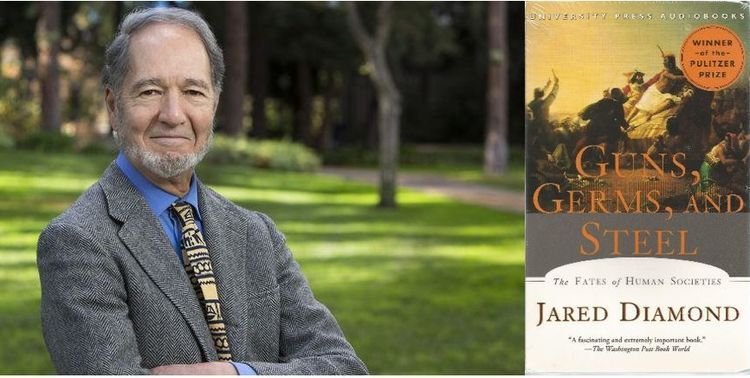Last year, Jared Diamond published a long account in The New Yorker of stories his driver in New Guinea had told him about a bloody feud he'd led in the New Guinea highlands. (I commented on it here.) Now, the driver and another man are suing Diamond for $10 million, saying the story isn't true.
From Chronicles of Higher Education:
”While acting on vengeful feelings clearly needs to be discouraged, acknowledging them should be not merely permitted but encouraged,” wrote Jared M. Diamond in an essay in The New Yorker last April.
Now two of the subjects of that essay are acknowledging their own vengeful feelings. This week a lawyer filed a $10-million defamation claim in a New York court on behalf of two Papua New Guinea men whom Mr. Diamond described as active participants in clan warfare during the 1990s.
Mr. Diamond, a professor of geography at the University of California at Los Angeles and the author of the best-selling Guns, Germs and Steel: The Fates of Human Societies (W.W. Norton, 1997), and Collapse: How Societies Choose to Fail or Succeed (Viking, 2004), based the essay almost entirely on accounts given to him by Hup Daniel Wemp, an oil-field technician who served as Mr. Diamond’s driver during a 2001-2 visit to New Guinea. (The full text of the essay is open only to New Yorker subscribers, but a long summary is available here.
Mr. Wemp is now one of the lawsuit’s two plaintiffs; the other is Henep Isum Mandingo, a man who, according to Mr. Diamond’s article, was attacked and paralyzed on orders from Mr. Wemp.
For nearly a year, Mr. Diamond’s article has been scrutinized by Rhonda Roland Shearer, director of the Art Science Research Laboratory, a multifaceted New York organization with a sideline in media criticism. Ms. Shearer, a sculptor and writer, is the widow of Stephen Jay Gould, who preceded Mr. Diamond as a widely esteemed public interpreter of science.
Gould's widow sure likes lawsuits. A few years ago she filed suit for malpractice against the doctor who had saved Gould's life from cancer in 1982.
The Stinky Journalism website run by her Art Science Research Laboratory says:
Art Science Research Laboratory (ASRL) is a not-for-profit, 501(3)c, founded by Stephen Jay Gould, and Rhonda Roland Shearer in 1996.
The notion of Stephen Jay Gould founding a website to combat "stinky journalism" is hilarious. This is a writer whose biggest bestseller, The Mismeasure of Man, remains the epitome of stinky journalism. High class stinky journalism is what made Mr. and Mrs. Gould rich. As the AP reported on Mrs. Gould's lawsuit against her late husband's doctor:
"The lawsuit does not specify the damages being sought, but says that Dr. Gould earned $300,000 a year from speaking engagements alone, that "a seven-figure income was his norm" and that when he died he was about to enter into a book contract for more than $2 million."
Here's Stinky Journalism's endless, poorly organized, poorly edited, and minor error-filled diatribe against Diamond.
This lawsuit against Diamond is also part of the cultural anthropology profession's war against Diamond (which I discussed in 2007), who has become a best-selling author by mixing the human sciences with Darwinism (while clinging hard enough to political correctness to stay in the money). Although Diamond has made a fortune by coming up with politically correct rationalizations for the obvious huge gaps in achievement among the races, to cultural anthropologists, he's not politically correct enough.
Forbes reports:
Complicating Wemp's case, perhaps, is an interview he gave to Shearer's researchers, in which he stated that the stories he told Diamond were in fact true.
But a Wemp friend and legal adviser, Mako John Kuwimb, explains: "When foreigners come to our culture, we tell stories as entertainment. Daniel's stories were not serious narrative, and Daniel had no idea he was being interviewed for publication."
Pacific Islanders are notorious for yanking the chains of visiting Western academics — just look at how Samoan girls snookered Margaret Mead in the 1920s. Moreover, guys like to tell stories about how tough they are, so when your driver tells you about how many men he's killed protecting his family's honor, you shouldn't necessarily take him all that seriously.
So, I have no idea if this story is true or not. Diamond's article was, literally, a story about a bunch of savages slaughtering each other in the jungle. That's the kind of thing that doesn't leave much of a paper trail.
I imagine Wemp would be happy to settle out of court for $100,000 or whatever, which is serious cash in PNG. Wemp's lawsuit is ridiculous because obviously Diamond didn't just make up the story. He heard it from Wemp, the plaintiff. The story Wemp told may or may not be true. If it's not, the other parties named in it may have some kind of case against Diamond for negligence in credulously believing a blowhard's tall tales. But Wemp doesn't have a leg to stand on.
But all this raises once again the question that comes up practically every time The New Yorker prints a Malcolm Gladwell article, such as the one libeling Charles Murray that led to a shaming retraction from Gladwell's editor David Remnick: Whatever happened to The New Yorker's famous Bright Lights, Big City-style factcheckers? Or have I answered my own question?













